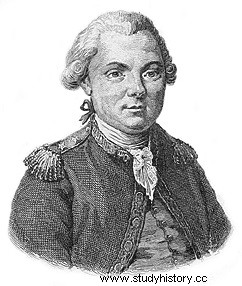
(Jean François de Galaup, count of)
(Le Guo, near Albi, 1741 - Vanikoro Island, 1788.) Navigator. A student at the Navy School, he then took part in several campaigns. La Pérouse was seriously wounded and taken prisoner aboard the Formidable on November 20, 1759, after Admiral Hawke's resounding defeat of Marshal de Conflans off Belle-Isle.
He distinguished himself as an officer during the American War of Independence:in 1779, he took part in the Battle of the West Indies; captain in 1780 aboard L’Astrée, he captured with La Touche-Tréville two ships near Île Royale; during a cruise in Hudson Bay in 1782, he seized the forts of Prince of Wales and York, which were razed to the ground. After the signing of the peace treaty of Versailles in 1783, he took the lead of a scientific expedition, prepared in the greatest secrecy by the entourage of Louis XVI who decided on the plans himself. This expedition is part of the series of explorations of the Pacific (1770-1778) facilitated by the discovery of the chronometer. After Cook, of whom he is the true successor, and Bougainville, La Pérouse completed the development of their preparatory technique:his laboratory boats were equipped with a chart room, a library and observation instruments; and he surrounded himself with a team of scholars (Louis Monge, La Martinière, Lesseps, etc.)
Leaving Brest on August 1, 1785 with two frigates, La Boussole and L'Aslrolabe, he doubled Cape Horn then ascended to Mount Saint-Hélié, on the northwest coast of America, from where Cook had been constantly pushed back by the currents (1756). This first recognition will later be completed by Vancouver. From there, he set sail for the Sandwich Islands (Hawaii), discovered Necker Island (September 5, 1786), reached Macao then the Philippines and went back to Japan.
August 2, 1787 , he recognizes the strait between Sakhalin Island and Korea. Then, crossing the Compass Channel, the chain of islands that extends the Japanese archipelago to Kamchatka, he arrived on September 7 in Petropavlovsk where he learned of his appointment to the rank of squadron commander. He then instructed Jean-Baptiste de Lesseps to bring his logbooks and maps to France through Siberia. From there, he intended to reconnoitre and survey the Kuril Islands, but the westerly winds forced him to abandon his project and, heading south, he reached the Archipelago of the Navigators (Samoa), where the captain of L'Aslrolabe, Floriot de Langle, was massacred, then the Friends Islands (Tonga). On January 26, 1788, he reached Botany Bay (in Australia) from where he sent a last letter on February 7. Then, after these thirty months of navigation, it is silence, and, for forty years, the mystery will hover over its destiny. In 1791, d'Entrecasteaux led a relief expedition. It is without result. The account of La Pérouse's voyage was published in 1808-1809. Finally, in 1826, the English captain Dillon recognizes, in the hands of an islander from Ticopia, a sword hilt engraved with the initials of La Pérouse and learns that it comes, as well as many objects, from the neighboring island of Vanikoro (in the Hebrides). Three years later, in 1829, the wrecks of L'Aslrolabe, which had been thrown by the storm on coral banks, were found by Dumont d'Urville. It was assumed that La Pérouse and his companions were massacred by the inhabitants of Vanikoro after the sinking.
